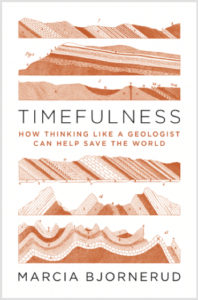 Marcia Bjornerud promises to teach skills that will help save the world. That’s no small task, but as a Professor of Geology at Lawrence University who has written an autobiography of the Earth, a paradigm shift in our thinking seems as natural as a shift in the tectonic plates.
Marcia Bjornerud promises to teach skills that will help save the world. That’s no small task, but as a Professor of Geology at Lawrence University who has written an autobiography of the Earth, a paradigm shift in our thinking seems as natural as a shift in the tectonic plates.
Bjornerud is a Fellow of the Geological Society of America and was a Fulbright Senior Scholar in Norway (2000-2001) and New Zealand (2009) as well as a contributing writer to the New Yorker’s science and technology blog.
 She’ll read from her new book, Timefulness: How Thinking Like a Geologist Can Help Save the World, on October 12 at 1:00 pm at the Neenah Public Library.
She’ll read from her new book, Timefulness: How Thinking Like a Geologist Can Help Save the World, on October 12 at 1:00 pm at the Neenah Public Library.
Marcia Bjornerud answered a few questions about what it means to examine what she calls the fingerprints of time.
Can you show us how you see the Lawrence campus?
The Lawrence campus, like most of the Fox Cities region, is built on the bed of a large lake that existed late in the Ice Age – Glacial Lake Oshkosh. Lake Winnebago occupies part of the basin of Lake Oshkosh but is about 10 times smaller. Old Lake Oshkosh blanketed the landscape with heavy clay—the bane of gardeners here. About 12,000 years ago, the lake finally drained into Lake Michigan as the glacial ice melted away and provided an outlet. The modern Fox River then became established, and it cut progressively down into the lake clay, locally exposing the 400-million-year-old bedrock. Lawrence’s Main Hall is built of that rock.
What are 3 to 5 tools besides your eyes that help you examine the world around you?
Geologists do have a wide array of tools for studying the Earth at many scales, from submicroscopic to planetary. Today we use many sophisticated methods to understand the planet, from various techniques in analytical chemistry, to satellite imagery, to geophysical methods for inferring what is in the subsurface.
But if I can venture into the realm of science fiction in answering your question, I’d choose
- X-ray vision to see inside mountains and deep into the crust; and
- a time machine to travel back into the past — and see what the future holds!
Can you tell us what you mean when you talk about the geologist’s habit of seeing everything?
Geologists can’t help but seeing the back stories everywhere in the landscape – the fingerprints of time and past processes are all over. To me, this deepens my experience of being alive on Earth. I feel a sense of connection with the cosmos.
It’s the long-term habit of thinking on geologic timescales that informs my worldview. I’ve done field work in remote parts of the world with other geologists from a wide range of cultures and stages of life. In any other context, we would probably not have been brought together, but our shared passion for understanding the natural world creates a strong, enduring feeling of connection and a sense of shared humanity.
You might enjoy learning from Marcia Bjornerud about the hidden history of High Cliff State Park before the Fox Cities Book Festival!





